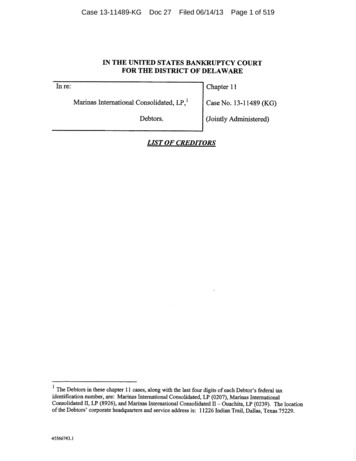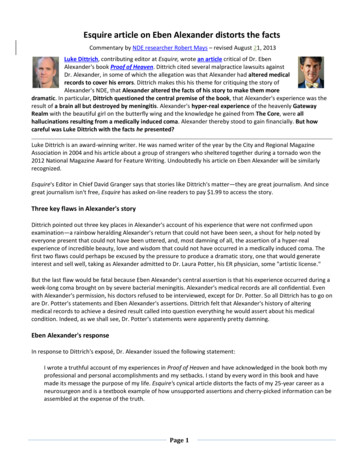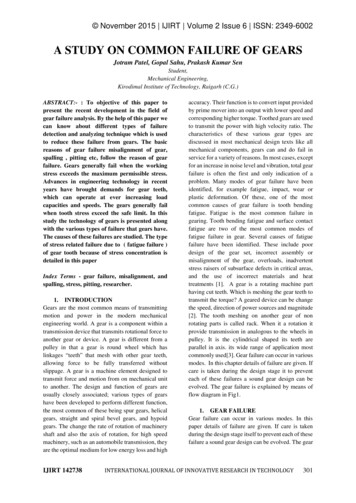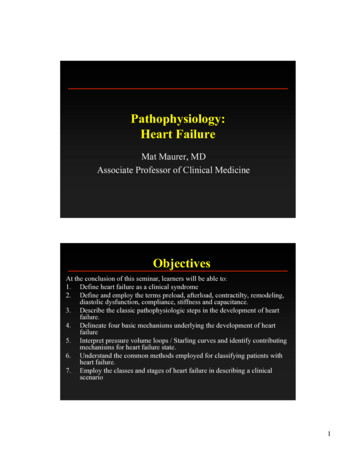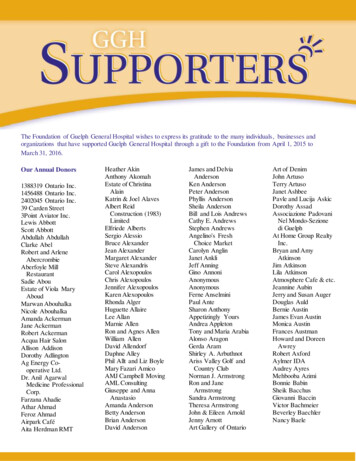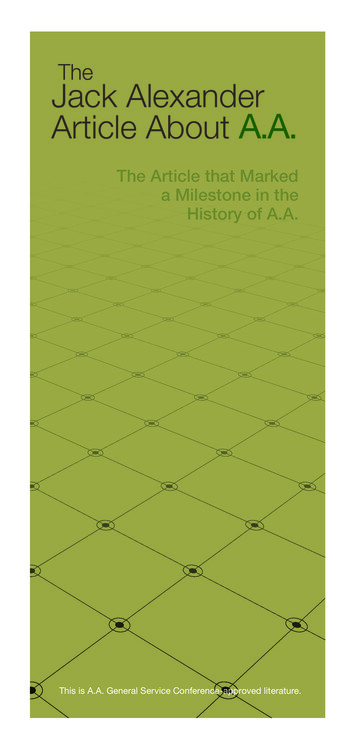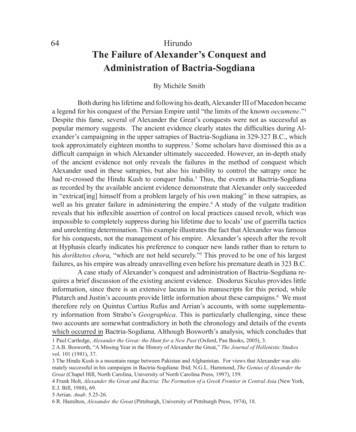
Transcription
64HirundoThe Failure of Alexander’s Conquest andAdministration of Bactria-SogdianaBy Michèle SmithBoth during his lifetime and following his death, Alexander III of Macedon becamea legend for his conquest of the Persian Empire until “the limits of the known oecumene.”1Despite this fame, several of Alexander the Great’s conquests were not as successful aspopular memory suggests. The ancient evidence clearly states the difficulties during Alexander’s campaigning in the upper satrapies of Bactria-Sogdiana in 329-327 B.C., whichtook approximately eighteen months to suppress.2 Some scholars have dismissed this as adifficult campaign in which Alexander ultimately succeeded. However, an in-depth studyof the ancient evidence not only reveals the failures in the method of conquest whichAlexander used in these satrapies, but also his inability to control the satrapy once hehad re-crossed the Hindu Kush to conquer India.3 Thus, the events at Bactria-Sogdianaas recorded by the available ancient evidence demonstrate that Alexander only succeededin “extricat[ing] himself from a problem largely of his own making” in these satrapies, aswell as his greater failure in administering the empire.4 A study of the vulgate traditionreveals that his inflexible assertion of control on local practices caused revolt, which wasimpossible to completely suppress during his lifetime due to locals’ use of guerrilla tacticsand unrelenting determination. This example illustrates the fact that Alexander was famousfor his conquests, not the management of his empire. Alexander’s speech after the revoltat Hyphasis clearly indicates his preference to conquer new lands rather than to return tohis doriktetos chora, “which are not held securely.”5 This proved to be one of his largestfailures, as his empire was already unravelling even before his premature death in 323 B.C.A case study of Alexander’s conquest and administration of Bactria-Sogdiana requires a brief discussion of the existing ancient evidence. Diodorus Siculus provides littleinformation, since there is an extensive lacuna in his manuscripts for this period, whilePlutarch and Justin’s accounts provide little information about these campaigns.6 We musttherefore rely on Quintus Curtius Rufus and Arrian’s accounts, with some supplementary information from Strabo’s Geographica. This is particularly challenging, since thesetwo accounts are somewhat contradictory in both the chronology and details of the eventswhich occurred in Bactria-Sogdiana. Although Bosworth’s analysis, which concludes that1 Paul Cartledge, Alexander the Great: the Hunt for a New Past (Oxford, Pan Books, 2005), 3.2 A.B. Bosworth, “A Missing Year in the History of Alexander the Great,” The Journal of Hellenistic Studiesvol. 101 (1981), 37.3 The Hindu Kush is a mountain range between Pakistan and Afghanistan. For views that Alexander was ultimately successful in his campaigns in Bactria-Sogdiana: Ibid; N.G.L. Hammond, The Genius of Alexander theGreat (Chapel Hill, North Carolina, University of North Carolina Press, 1997), 159.4 Frank Holt, Alexander the Great and Bactria: The Formation of a Greek Frontier in Central Asia (New York,E.J. Bill, 1988), 69.5 Arrian. Anab. 5.25-26.6 R. Hamilton, Alexander the Great (Pittsburgh, University of Pittsburgh Press, 1974), 18.
Michèle Smith Alexander’s Failures in Bactria-Sogdiana65Curtius’ account is more reliable for this period is undoubtedly ambitious, his argumentswill be used throughout this paper.7 Indeed, Bosworth is correct in stating that Arrian’saccount seems to suffer from distortions, caused by a break in the narrative to discuss incidents such as the Cleitus affair, as well as recording “doublets” in Ptolemy and Aristobulus’accounts.8 Thus, despite the fact that the vulgate tradition is often dismissed as less reliablethan Arrian’s account, Curtius’ chronology, with a more spaced campaign narrative ratherthan a crowd of events in 327 B.C., will be generally accepted due to the weakness of Arrian’s version of events for this period.9 In any case, these accounts are not so divergentthat they hinder a study of Alexander’s attempt to conquer and administer these satrapies.A close examination of the causes of the revolts, which tooknearly two years to suppress, is seminal for an understanding of the conquest of Bactria-Sogdiana.10 Both Arrian and Curtius’ accounts agree that when Alexander firstcrossed the Hindu Kush into this satrapy he encountered little resistance. The Bactrian cavalry abandoned Bessus as Alexander approached, and Alexander was ableto take both the cities of Bactra and Aornus on his first attempt.11 In fact, Bessus wascaptured and given to Alexander as a form of submission by his own nobles after Alexander crossed the Oxus River in pursuit of this claimant to the Persian throne.12However, the ease of this expedition was to prove misleading, since within weeks ofBessus’ capture revolt erupted.13 This change in attitude towards Alexander can be explainedby Alexander’s more direct and controlling methods of administration in this area comparedto previous Persian rule. Archaeological data from the Achaemenid period infers that militaryconquest did not leave a large material impact on the region, and there was much stability inlocal customs, particularly in pottery and hydraulic technology. This strongly suggests thatAchaemenid rule was “no more than a kind of politico-military epiphenomenon,” in whichthe Persian kings imposed relatively little direct control on these satrapies.14 Considering7 P. Gaukowsky, “Recherches Récentes sur Alexandre le Grand” (1978-1982), REG 96 (1983), 239.Gaukowsky described Bosworth’s method as “égaliser une matière historique dont la plasticité étonne.”8 See Bosworth 1981, 17.9 Ibid, 33.10 A.B. Bosworth, “Review: Alexander the Great and Bactria: The Formation of a Greek Frontier in CentralAsia” The Journal of Hellenistic Studies vol. 110 (1980), 256.11 Bactrian cavalry abandoning Bessus: Curt. 7.4.20; Arr. Anab. 3.28.10; Conquest of Bactria: Arr. Anab.3.29.1; Curt. 7.4.22-32, 7.5.1.12 Curt. 7.5.22-26; Arr. Anab. 3.30.1-5. Arrian relates two accounts, the first by Ptolemy in which he personally delivered Bessus to Alexander since Bessus’ subordinates were still uncertain of whether to submit, as wellas Aristobulus’ account which states that Spitamenes gave Bessus to Alexander himself. Aristobulus’ story ismore likely, see A.B. Bosworth, Conquest and Empire: the reign of Alexander the Great (Cambridge: Cambridge University Press, 1988), 108.13 Frank Holt, Into the Land of the Bones: Alexander the Great in Afghanistan (Berkeley: University ofCalifornia Press, 2005), 45; Hammond 1997, 144; Unrest began with a group of foraging Macedonians beingambushed: Arr. Anab 3.30.11, 4.1.4-5; Curt. 7.6.1-4.14 Pierre Briant, From Cyrus to Alexander: a History of the Persian Empire, trans. Peter T. Daniels (Winona
66Hirundothis, it is unsurprising that Alexander’s pillaging of villages along the Tanais following anambush, as well as his preparations to built Alexandria-Eschate as a new military-politicalcenter in the area, would cause outward rebellion. This was a strong imposition on localinstitutions and necessitated the annexation of land from locals, which was sure to igniteopposition.15 These rebellions were in fact led by Bessus’ usurpers, principally Spitamenes,which suggests that the local aristocracy did not support this new form of administration.16Furthermore, the appointment of the “alien” Artabazus from the Western satrapies followed by the Macedonian Amyntas, rather than leaving an incumbent satrap as he did in Areia, would have also stirred resentment.17 Bessus’ local support (albeit short-lived) as satrap of Bactria was apparent when Bactrians supported his claimto the throne; the appointment of such a foreign satrap therefore appeared to the localsas a significant change from previous Achaemenid custom.18 Furthermore, althoughOnesicritus’ account of Alexander banning the “barbarian” custom of “underdogs” eating the remains of the dead in Bactra has been doubted, this may suggest that Alexander also encountered native customs with which he was not familiar or respectful.19Bosworth criticizes the argument that regulating contact between the Sogdians and Scythians would have also caused revolt, but archaeological evidencepoints that there was active trade between the Scythians and Bactria-Sogdiana. For instance, the carpets with Achaemenid motifs found in a Uralic tomb on Pazyryk.20 Furthermore, Arrian writes of how the Scythian and Bactrian horsemen fought alongside one another. 21 Thus, Alexander’s warning against the Scythians “not to cross theriver Tanais without the king’s order,” and therefore the imposition of direct controlover exchange and movement across the river, represents a break with previous socioeconomic customs and would have also caused resentment and revolt from both Bactrian-Sogdian and Scythian locals.22 Although similar methods of creating militarybarriers had worked with the Scythians in the Balkans in 336 B.C., these tactics proved toorigid to adapt to this new geographic and cultural situation.23 Thus, the management of thissatrapy reflected Alexander’s lack of understanding of the importance of maintaining previous Persian administration methods, since their balance of local and Persian institutions alLake, IN: Eisenbraun, 2002), 76.15 P.M. Fraser, Cities of Alexander the Great (Oxford: Clarendon Press, 1996), 67; Holt 2005, 48; Bosworth1980, 257; Curt. 7.6.10, 12-13; 7.6.24-27; Arr. Anab. 4.1.3; 4.4.1-4.16 Curt. 7.6.15; Arr. Anab. 4.3.6.17 Bosworth 1980, 257; Arr. Anab. 3.29.1; Curt. 7.5.1-2.18 Curt. 5.10.5-6; Arr. Anab. 3.21.4.19 Onesicritus’ account is found in Str.11.11.3; Holt 200, 526; W.W. Tarn, The Greeks in Bactria & India (Chicago, Ares Publishers, 1985), 115-116.20 Briant 2002, 747.21 Ibid; Arr. Anab. 3.13.3.22 Briant 2002, 747; Curt. 7.6.12; Arr. Anab. 4.1.3.23 Arr. 1.4.1-5; Holt 2008, 47.
Michèle Smith Alexander’s Failures in Bactria-Sogdiana67lowed the Achaemenids to maintain legitimacy and at least nominal control of these areas.24The revolts and guerrilla warfare caused by these changes in administration and infrastructure were disastrous to the Macedonian army since this alien form of warfare provedextremely difficult to suppress. Alexander responded to the first guerrilla assaults againsthis troops by destroying several cities. Although this was meant to “serve as an example tokeep the others in line,” the destruction of local settlements seems to have only contributedto the locals’ animosity towards Alexander since the revolt quickly spread from northernSogdiana southward to the Hindu Kush.25 One assault against a Macedonian contingentwhich was sent by Alexander to defend Maracanda against Spitamenes was particularly catastrophic. Arrian and Curtius do not record the same the details of this event, but they generally agree that this was a military disaster in which the Macedonian troops were caught bysurprise and killed en masse.26 This emphasizes a great failure in Alexander’s expectationsof this mission. If Arrian’s account is correct that Alexander appointed an interpreter ratherthan a general to lead this operation, this demonstrates that Alexander was not expecting theMacedonian force heading to Maracanda to encounter a guerrilla military engagement.27In any case, Alexander’s “hammer-and-anvil” tactics could not be used againstthe Bactrian-Sogdian rebels, since these opponents would not fight a decisive battleagainst him, preferring guerrilla warfare instead.28 In order to regain control of the satrapy, in the spring of 328 B.C. Alexander resolved to divide his forces into smaller formations in order to deal with each of the revolts individually.29 The risk in Alexander’sspreading of his troops so widely across the upper satrapies can be seen by the defeatof a small garrison of invalid soldiers at Zariaspa in 328 B.C. while Bactrian-Sogdiantroops were raiding neighbouring villages. Although Craterus was able to come rapidlyand defeat the insurrection, both Arrian and Curtius record that several of the enemiesmanaged to flee, including Spitamenes.30 These measures of destroying towns and villages to stop any form of resistance have caused some scholars to estimate that over100,000 Bactrians were killed.31 Only after Spitamenes was betrayed by his own subordinates, or wife according to Curtius, as well as the successful siege of Sisimithres’rock in eastern Sogdiana in late 328/327 B.C., did the rebellion begin to subside.3224 Maria Brosius, “Alexander and the Persians,” in Brill’s Companion to Alexander the Great, ed. Joseph Roisman (Leiden, Brill, 2003), 192.25 Curt. 7.6.16; Bosworth 1980, 256; Barry S. Strauss, “Alexander: the military campaign,” in Brill’s Companion to Alexander the Great, ed. Joseph Roisman (Leiden, Brill, 2003), 141-142. Destruction of cities: Arr. Anab4.2.4-4.3.4; Curt. 7.6.16-23.26 Curt. 7.7.30-39; Arr. Anab 4.5.5-6.27 Holt 2005, 54; Arr. Anab. 4.3.7.28 Holt 2005, 66; Strauss 2003, 152-153.29 Curt. 8.1.1-2; Arr. Anab. 4.16.1-3.30 Curt. 8.1.1-6; Arr. Ana .4.16.4- 17.2.31 Holt 2005, 58; deriving figure from the index of Diodorus Siculus’ Book 17.32 Death of Spitamenes: Curt. 8.3.1-16; Arr. Anab 4.17.7; Capture of Sisimithres’ rock: Curt. 8.2.19-33. Cal-
68HirundoThese difficulties would have greatly reduced the morale of the Macedonianarmy. Unlike previous decisive battles, the military confrontations in Bactria-Sogdianawere continuous. Furthermore, the ancient sources’ reports of Alexander’s injuries whilefighting against these guerrilla attacks show the continuous risk that every soldier faced.33It has been recorded that Artabazus’ retirement in 328 B.C. could not have been due to oldage, since he was barely sixty. This further suggests the great difficulty in administeringBactria-Sogdiana if Artabazus did indeed plead to be removed from his office.34 Thesemilitary difficulties were compounded by the harsh environment. The soldiers had to endure both the fierce cold of the Hindu Kush Mountains and Sogdian blizzards as well as theunbearable heat of the Turkestan desert from Bactra to the Oxus River.35 Although thismay be a literary exaggeration by the ancient sources, it is well known that the environment in modern-day Afghanistan is not particularly amenable to travelers.36 It is estimatedthat approximately 7,000 Macedonian soldiers died, which far exceeded casualties in anycampaigns before that time.37 These military and environmental conditions would havecontributed to unrest and dissatisfaction, which eventually led to the mutiny at Hyphasis.38Considering these difficulties, it is interesting to see Alexander’s change of tactics in 327 B.C., especially concerning Sisimithres’ treatment in comparison to Arimazes’punishment in 328 B.C.39 According to Curtius, after Arimazes’ rock surrendered in 328B.C., Alexander ordered that his family and prominent noblemen should be crucified andthe rest of the population enslaved.40 Although Arrian, who places this account later in327 B.C., does not mention this, Bosworth has concluded that this incident would be consistent with Alexander’s general military policy, and that one could argue that Arrian’ssources would be likely to omit this event due to the harsh nature of this punishment.41Thus, this plausible event can be heavily contrasted to Curtius’ account of the surrenderof Sisimithres’ rock in 327 B.C. Rather than destroying the settlement as he had done toseveral cities including Cyropolis, or massacring the whole population, Alexander alliedhimself to Sisimithres.42 This proved to be particularly useful when he sent Alexanderlim. 4.21.1-9. The narrative above is relying on the Curtius’ rather than Arrian’s chronological narrative; seeBosworth 1981.33 One of first assaults Alexander shot through the leg: Arr. Anab. 3.30.11; Curt. 7.6.1-4; Alexander knockedunconscious during siege of cities (perhaps Cyropolis): Curt. 7.6.22; Arr. Anab. 4.3.3.34 Bosworth 1988, 237; Curt. 8.1.19; Arr. Anab. 4.17.3. Both sources attribute his retirement to old age.35 Crossing Hindu Kush: Curt. 7.4.22; Arr. Anab 3.28; Crossing Turkestan desert: Curt.7.5.1-18; surviving theSogdian blizzard: Curt. 8.4.1-17.36 Holt 2005, 107.37 Ibid; Frank Holt, Alexander the Great and the Mystery of the Elephant Medallions (Berkeley: University ofCalifornia Press, 2003), 14.38 Arr. Anab. 5.28.1 – 29.1; Curt. 9.3.1-20.39 This is assuming that one except Curtius Rufus’ chronology of events; see Bosworth 1981.40 Curt. 7.11.27-29.41 Bosworth 1981, 32-33; Curt. 7.11.27-29; Arr. Anab. 4.19.4.42 Curt. 8.2.28-33.
Michèle Smith Alexander’s Failures in Bactria-Sogdiana69rations during the Sogdian blizzard.43 Alexander’s marriage to Roxane can be similarlyviewed as politically motivated, rather than due to infatuated love as the sources suggest.44As the daughter of the Bactrian baron Oxyartes, Alexander’s marriage to Roxane wouldcreate a tie between him and a prominent clan of the region, which would therefore aid inconciliating the remaining unrest in Bactria.45 These policies therefore suggest that Alexander could have been attempting a policy of conciliation, after realizing that solely usingmethods of repression was not subduing the revolt. These methods of conciliation wouldhave also been more likely after the betrayal of Spitamenes, since this would suggest the“war weariness of most Bactrians and Scythians.”46 Thus, Alexander was finally able toextract himself from Bactria-Sogdiana to continue on his Indian Campaign in 326 B.C.However, events described by the ancient sources after Alexander left the upper satrapies for his Indian campaign demonstrate that this area was far from subdued. AlthoughAlexander’s departure from Bactria-Sogdiana naturally causes the literary evidence to shiftaway from these satrapies, “leaving everything else in shadow,” there are several indicationsthat there were continuing difficulties in managing this area.47 According to Arrian, Alexander left a large garrison of 10,000 infantry and 3,500 cavalry, which was approximately aquarter of the size of the Macedonian army at Gaugamela and the largest defence force leftin the empire.48 This large garrison strongly suggests that Bactria-Sogdiana had not beencompletely pacified when Alexander left for India. Furthermore, according to both Diodorus Siculus and Curtius, Greek colonists began an armed insurrection with the cooperationof locals and attempted to return to Greece in approximately 326 B.C.49 This behaviour isreminiscent of a comment Cleitus supposedly made regarding his satrapy of Bactria duringthe banquet before his murder, that “I am being sent against wild animals with bloodthirstynatures.”50 This revolt also mirrors the later attempt of thousands Greek colonists in theupper satrapies to return West after Alexander’s death in 323 B.C.51 Thus, these events indicate that the Greek mercenaries left in Bactria-Sogdiana were unwilling to colonize theseareas. Furthermore, these rebellions equally suggest that Alexander’s methods of repres43 Ibid: 8.4.18-20.44 Arr. Anab. 4.19.5-6; Curt., 7.4.23-26, Str 11.11.4.45 Holt 2005, 90-91; Elizabeth D. Carney, “Women in Alexander’s Court,” in Brill’s companion to Alexanderthe Great, ed. Joseph Roisman (Leiden, Brill, 2003), 245-246; A.B. Bosworth, “Alexander and the Iranians,”The Journal of Hellenistic Studies vol. 100 (1980), 10.46 Holt 2005, 84.47 Other authors, such as Hammond (1997, 159) suggest Bactria-Sogdiana was in “settled conditions.”48 Holt 1988, 81; Bosworth 1988, 238; Fredrick Hiebert and Pierre Cambon,Afghanistan: Hidden Treasures from the National Museum, Kabul (Washington, D.C., National Geographic,2008), 81.49 Curt., 9.7.1-6. Diodorus states that the soldiers, upon hearing that Alexander had died when he was badlyinjured during his campaign against the Sydracae in 326 B.C., began to revolt and demand to return home.Diod. Sic. 17.99.5.50 Curt. 8.1.35. Arrian does not record that Cleitus was appointed as satrap of Bactria before he was murdered.51 Diod. 18.7.
70Hirundosion could only work effectively when he was in the vicinity. As soon as Alexander continued onwards to his next conquest dissatisfied Greeks and locals alike were free to rebel.Arrian reveals in 326 B.C. that the Assacenians near Bactria-Sogdiana were alsorevolting; the fact that Tyriespis, the governor of the Kabul region, was sent to deal withthe revolt suggests the gravity of the situation.52 Alexander executed the same Tyriespisfor “outrageous” behaviour in 325 B.C., indicating further unrest and problems with administration in the upper satrapies.53 In fact, the appointment of Roxane’s father, Oxyartes,over greater territory than Bactria suggests his dependence on marital ties to this particularBactrian clan to keep control.54 One may argue that some form of administrative controland influence is demonstrated by the excavation of the Greek colony of Aï Khanoum,which was inhabited until the late second century B.C., and shows continuing influencesfounded by Alexander. However, it has recently been concluded by archaeologists thatthe foundations date from Seleucus’ reign in 300 B.C. 55Thus, it is apparent that BactriaSogdiana continued to suffer from military and political unrest throughout the 320s B.C.,and seems not to have had any strong politico-military centers and infrastructure, due tothe fact that both locals and Greek colonists were disaffected and prone to rebellion.56Thus, the case study of the campaigns and administration of Bactria-Sogdiana reveals several of the overarching problems Alexander faced after having conquered the Persian Empire. Alexander’s lack of understanding of local socio-economic and administrative institutions caused resentment and rebellion in satrapies whichwere initially willing to cooperate with his nominal control. Moreover, the institutionsand colonies which he did create before rapidly turning to the conquest of India wereincomplete, as demonstrated by rebellions of both the Greek colonists and local inhabitants when Alexander left. Similar problems of administration and control can be detected in other areas of the empire: for example, Satibarzanes began a revolt in Areiashortly after Alexander left in pursuit of Bessus in 329 B.C.57 In fact, on Alexander’sreturn from India in 325/324 B.C. most satrapies were revolting against Macedoniancontrol.58 Thus, perhaps Plutarch’s description of Bactrian revolts as “the heads of hydra which ever grew again” could apply to the other satrapies of the empire.59 Thus, theevents in Bactria-Sogdiana, although somewhat hidden in our sources, provide an interesting case study of Alexander’s failed methods of administration in the Persian Empire.52 Arr. Anab. 5.20.7; Holt 2005, 109.53 Arr. Anab. 6.15.3; Curt. 9.8.9.54 Curt. 9.8.10; Arr. Anab. 6.15.3.55 Holt suggested that Aï Khanoum could have grown from a settlement founded by Alexander or Hephaestion,Hiebert states that the archaeological evidence supports a later foundation date. Holt 1988, 42; Hiebert 2008,82-83.56 Susan Sherwin-White and Amélie Khurt, From Samarkhand to Sardis: A new approach to the Seleucidempire (London, Gerald Duckworth & Co., Ltd., 1993), 9.57 Curt. 6.6.20; Arr. Anab. 3.25.5.58 Brosius 2003, 189.59 Plutarch, Mor. 341 F.
Michèle Smith Alexander’s Failures in Bactria-SogdianaBibliography71Primary Sources:Arrian. Anabasis Alexandri. Trans. P.A. Brunt. Cambridge, MA: Harvard UniversityPress, 1976.Callimachus. Hymns and Epigrams. Lycophron. Aratus. Trans. A.W. Mair and G. R. Mair.London: William Heinemann, 1921Diodorus Siculus. Bibliotheca historica. Trans. John Skelton. London: Oxford UniversityPress, 1956-1957.Plutarch. Moralia. Trans. Frank Cole Babbitt. London: Harvard University Press, 1927.Quintus Curtius Rufus. Historiae Alexandri Magni. Trans. John Yardley. New York:Penguin Books Ltd, 1984.Strabo. Geographica. Trans. Horace Leonard Jones. Cambridge: Cambridge UniversityPress, 1961.Secondary Sources:Bosworth, A.B. “Alexander and the Iranians.” The Journal of Hellenistic Studies vol. 100(1980): 1-21.----. “A Missing Year in the History of Alexander the Great.” The Journal of HellenisticStudies vol. 101 (1981): 17-39.----. Conquest and Empire: the reign of Alexander the Great. Cambridge: CambridgeUniversity Press, 1988.----. “Review: Alexander the Great and Bactria: The Formation of a Greek Frontier inCentral Asia.” The Journal of Hellenistic Studies vol. 110 (1980): 256-258.Briant, Pierre. From Cyrus to Alexander: a History of the Persian Empire. Trans. T.Daniels. Winona Lake, IN: Eisenbraun, 2002.Brosius, Maria. “Alexander and the Persians.” In Brill’s Companion to Alexander theGreat. Ed. Joseph Roisman. Leiden: Brill, 2003: 169-194.Carney, Elizabeth D. “Women in Alexander’s Court.” In Brill’s Companion to Alexanderthe Great. Ed. Joseph Roisman. Leiden: Brill, 2003: 227-252.Cartledge, Paul. Alexander the Great: the Hunt for a New Past. Oxford: Pan Books, 2005.Fraser, P.M. Cities of Alexander the Great. Oxford: Clarendon Press, 1996.Gaukowsky, P. “Recherches Recents sur Alexander le Grand (1978-1982).” REG 96(1983): 225-241.Hamilton, J.R. Alexander the Great. Pittsburgh: University of Pittsburgh Press, 1974.Hammond, N.G.L. The Genius of Alexander the Great. Chapel Hill, North Carolina:University of North Carolina Press, 1997.
72HirundoHiebert, Fredrick and Pierre Cambon. Afghanistan: Hidden Treasures from the NationalMuseum, Kabul. Washingon, D.C.: National Geographic, 2008.Holt, Frank. Alexander the Great and Bactria: The Formation of a Greek Frontier inCentral Asia. New York: E.J. Bill, 1988.----. Alexander the Great and the Mystery of the Elephant Medallions. Berkeley:University of California Press, 2003.----. Into the Land of the Bones: Alexander the Great in Afghanistan. Berkeley:University of California Press, 2005.Sherwin-White, Susan and Amélie Khurt. From Samarkhand to Sardis: A New Approachto the Seleucid empire. London: Gerald Duckworth & Co., Ltd., 1993.Strauss, Barry S. “Alexander: the military campaign.” In Brill’s Companion to Alexanderthe Great. Ed. Joseph Roisman, 133-158. Leiden: Brill, 2003.Tarn, W.W. The Greeks in Bactria & India. Chicago: Ares Publishers, 1985.
mately successful in his campaigns in Bactria-Sogdiana: Ibid; N.G.L. Hammond, The Genius of Alexander the Great (Chapel Hill, North Carolina, University of North Carolina Press, 1997), 159. 4 Frank Holt, Alexander the Great and Bactria: The Formation of a Greek Frontier in Central Asia (New York, E.J. Bill, 1988), 69. 5 Arrian. Anab. 5.25-26.

